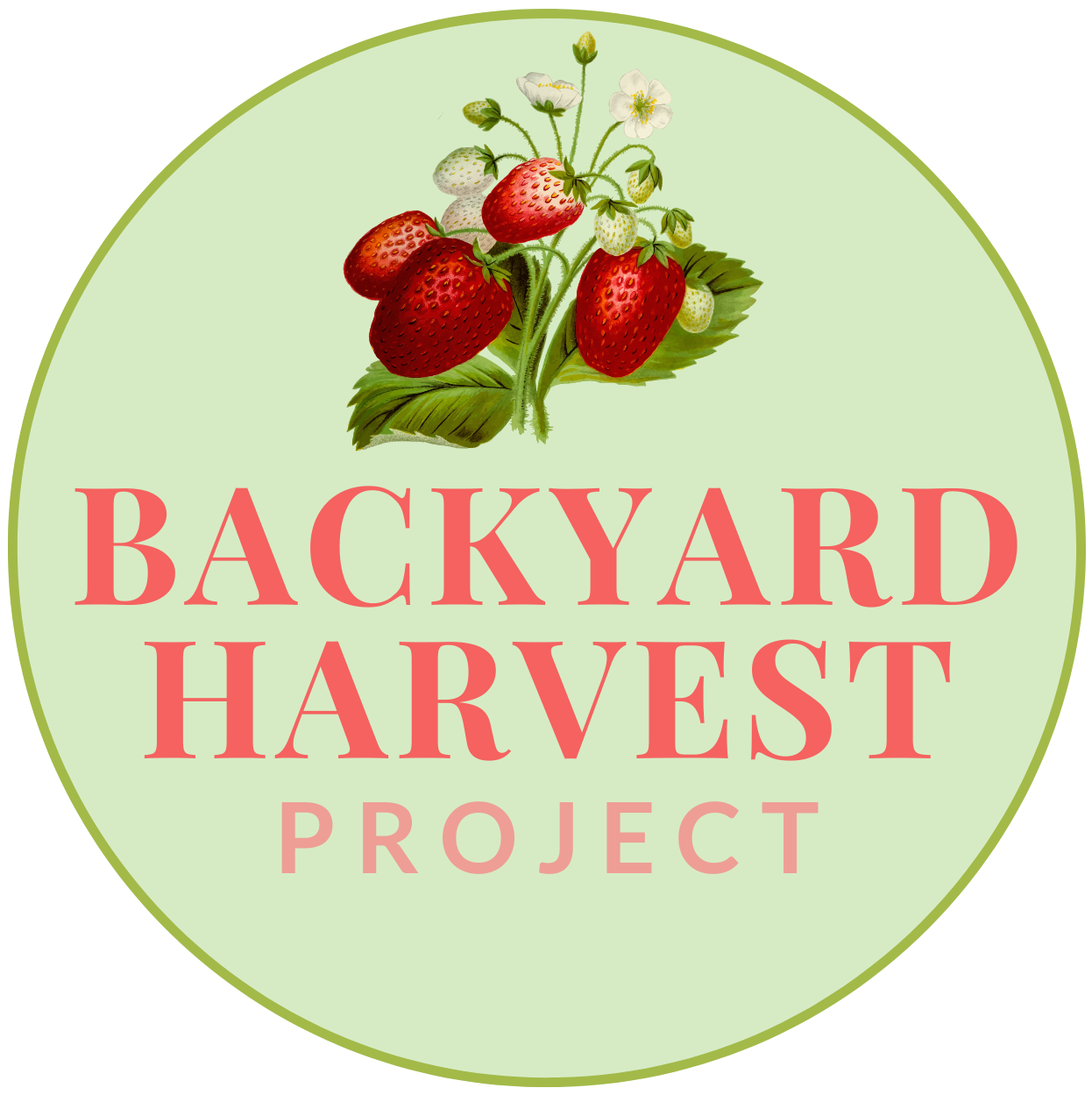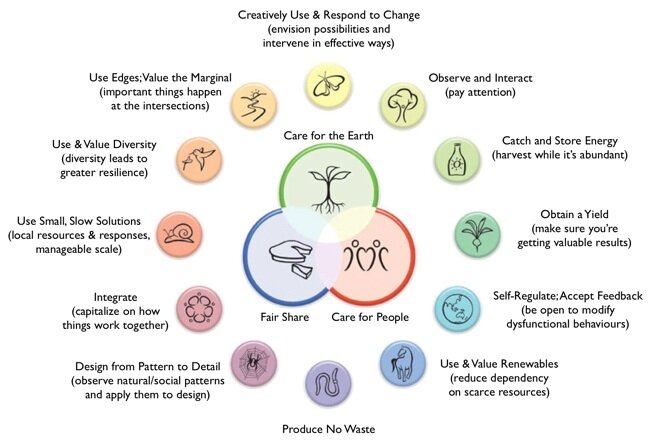The 12 Principles of Permaculture
If you ask someone what permaculture is, you better have a full beverage and a comfortable chair to sit in. It is a complicated concept, one that can be applied to much more than gardening (many of the principles of permaculture are also ring true as life values). Instead of a definition here, I am going to share the three values, and 12 principles of permaculture design.
Permaculture begins with three core values, centred in the image above. In applying Permaculture Design, all three have to be considered. You can’t pick and choose.
Three core values:
Care for the Earth
Care for People
Fair Share (or, setting limits on consumption, and returning surplus). I’ve also heard this one described as future care.
It is followed by a set of 12 Principles:
Observe and Interact
Identify your bias, sit back, and start observing and recording data, mother nature has much to teach us.
How to apply this to your urban space: while it’s exciting to get started on a new garden, take some time to just observe. Where is the sun? The water? The wind?
Catch & Store Energy
On the land, energy is much broader than you might imagine. It includes sunlight, water, seeds, organic matter, and out own time and energy.
How to apply this to your urban space: There are so many ways to apply this! When you are getting started two simple ways to apply this include setting up a rain barrel, and planting trees (which are amazing collectors of sun and water)
Obtain a Yield
When you hear ‘yield’ you are likely thinking food. But yield can be so much more - relaxation, creating a space to connect and beauty could all be yields.
How to apply this to your urban space: Spend some time thinking about what yields matter to you. An obvious yield is harvesting fruits, veggies, and herbs. One of my favourite yields is calm and relaxation - to achieve this yield, I was sure to include more private spaces in my design for this exact purpose.
Self-Regulate, Accept Feedback
Observation never stops. Most gardeners are constantly learning what works, and what doesn’t. Each year we have an opportunity to try new things based on what we learned the year before.
How to apply this to your urban space: start a garden journal to record what worked well, and what didn’t. You can apply your new knowledge each year.
Use & Value Renewables
This speaks to really thinking on what resources are renewable, and how we can best use them as part of our garden systems. Use as many natural resources as you can, while reducing the use of non-biological resources.
How to apply this to your urban space: Great examples of renewable resources include seeds, rainwater, and leaves (for your compost!)
Produce No Waste
Do you ever notice how no one has to mow or clean up the forest? Nature efficiently recycles waste, and we can too.
How to apply this to your urban space: Keep a compost pile. All of that garden ‘waste’ suddenly becomes an invaluable source of nutrients for next years plants.
Design from Patterns to Details
This goes back to that observation principle - once you observe and name the patterns, you can use them in your design.
How to apply this to your urban space: We have a corner of our yard that is notoriously wet and shady (that’s a pattern). We’ve planted mosses, ground cover & wet loving plants in this area, and created a fairy garden. Instead of trying to change patterns, design your space to embrace them.
Integrate rather than segregate
This is a big one in permaculture - it speaks to each element having various interconnecting functions. The word we frequently use is “stacking functions”.
How to apply this to your urban space: In your first year of gardening, you plant an apple tree. You also build a privacy screen (your neighbors can see into your yard), purchase compost for your vegetable beds, buy an umbrella to give you afternoon shade, and buy a trellis for your clematis vine. What if we used stacking functions? This time you plant an apple tree so it blocks your neighbors view. You place your patio under the apple tree, giving you that afternoon shade, and plant your vine at the base so it can climb the apple tree. You rake the leaves from the apple tree in the fall to use in your new compost pile.
Use small and slow solutions
Mother nature rarely does an overhaul in any space, she takes her time. Ecosystems change slowly, from season to season, year to year, decade to decade. In permaculture we try to mimic that approach. Small and slow solutions is the opposite of “go big or go home”. When we do things slowly, it gives us time to observe and respond (and makes our mistakes more manageable).
How to apply this to your urban space: Try ideas first. Observe, adjust, then replicate. Perhaps you’ve decided it’s time to collect rain water. Instead purchasing a system to install on all of your downspouts, try setting up just one. Observe the system - is anything missing? Do you wish you had larger storage containers? Where does your overflow water go? After a few months of observing, you’ll be ready
Use and value diversity
Monoculture is commonplace in large scale agriculture - a whole field with just one plant (say canola, or wheat). Acres, and acres of just one plant. If you observe Mother Nature, you’ll notice she isn’t into monoculture. She has a diversity of plants and animals working together (it’s those stacking functions!). Diversity increased resilience (and not just in the garden, but that’s another blog post).
How to apply this to your urban space: When you think of a garden, the first image that pops into your mind might be a square with perfectly straight rows and black dirt in between. Food forests are a different kind of garden. They mimic nature by using a diversity of complimentary plants, many of them edible. They look just like a mini forest - no rows, lots of mulch and ground cover, and different layers (tall trees, shrubs, smaller plants, vines, ground cover).
Optimize edge and value the margins
Honestly, I struggle to explain this principle. Put simply, when two things meet, there is diversity and potential. Take this concept outside the garden - when you collaborate with another person, you each bring ideas to the table, and then create ideas together - the sum of your ideas are much greater, and much more diverse. In gardening, the edge often refers to physical space - where two ecosystems meet. Garden edges have more diversity, and often capture energy more efficiently. Overall, we accept the more edge, the better. Mother nature makes patterns that increase edge. The spiral is a classic example, so is a meandering river.
How to apply this to your urban space: Try planting trees or shrubs around a garden in a U-shape facing the sun. This is called a sun trap, and by increasing the edge (the U has more edge than a straight line), you can capture and hold heat and sunshine for sun loving plants.
Creatively Use and Respond to Change
This principle applies to so much more than the garden, it can be a guiding principle in life. Instead of seeing change as a downfall, accept it as an opportunity. Proactively, we can create resilient systems that can withstand change without completely failing.
How to apply this to your urban space: In your Zone 3 garden the weather is always unpredictable, in Calgary, you can almost always expect hail. Instead of waiting for a devastating hail storm, be creative and design beds with hail protection in mind.

